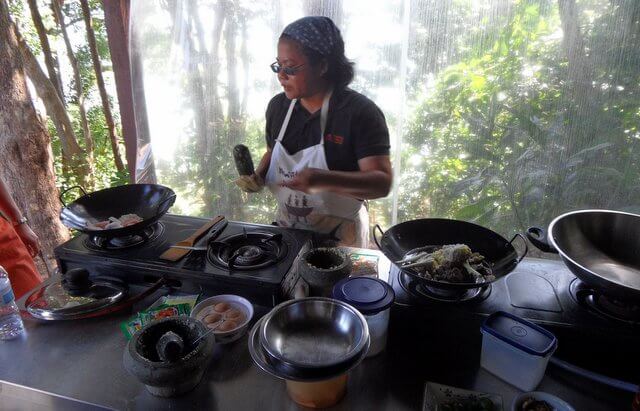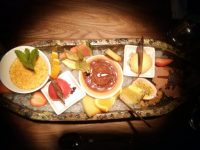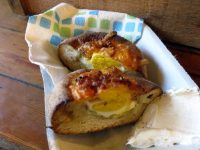
Encouraged by the flavours of the previous night’s meal we signed up at the last minute for a half-day Malaysian cookery class.
Not having read the itinerary of the only class available at such short notice we weren’t quite sure where we were going, but a friendly driver picked us up from the hotel and immediately launched into a twenty minute tirade on the rising property prices on the island. We were driving round the coast from Georgetown to the resort of Batu Ferrenghi, a popular destination for beach-lovers and fans of tacky looking restaurants. He showed us all the new property developments on the way and gave us a rundown of all the features and benefits of each housing complex, whilst bemoaning the cost. Admittedly some of the high rise blocks were ugly, but had amazing specs including a swimming pool on the sea-facing balcony and comparatively low prices to London or Beijing, but it seemed like a bad time in his life to mention anything positive, so I kept quiet.
More interesting was the still visible aftermath of the 2004 tsunami. It didn’t hit with full force here but still washed away many of the ramshackle homes of the fisherman and their families. We could see how far the waters had risen up the shoreline and still spy the remnants of their wooden huts. These were quickly replaced with prefab buildings and only recently have the families been moved to permanent newly built housing, still on the shore of their island.
Their fishing boats were moored outside our first stop, an unexpected visit to the Penang National Park (Taman Negara Pulau Pinang). This is one of the few remaining forests left on the island and at just 9.9sq miles it is the world’s smallest national park. We walked out on the jetties among the boats to an attractive little gazebo at the end of the pier, from which could be seen the floating villages. These are home to fishing tribes, some of whom have never set foot on land.
Back at the park entrance there is a Nature Interpretation Centre which gives a brief but interesting overview of the huge variety of flora and fauna in such a small park, and the six different habitats it contains. These are mangroves, wetlands, turtle nesting beaches, coral reefs, mudflats and a meromictic lake, which is one that occurs seasonally, with distinct layering of waters.
Cookery Class
Our next stop was the local wet market, where we were supposed to just look round at the live fish, animal parts and spice stalls. Instead we bumped into Nazlina, our chef/teacher who was doing the shopping for our upcoming class, so fortunately we were able to choose the dishes we’d learn to cook. After watching her buy the best spices we also took the opportunity to stock up on the same whilst they were so cheap and ended up with about 30 meals worth of various spices and powders for the price of a couple of Cokes.
Nazlina hopped on her scooter and we followed her down the road to our cookery class destination, which turned out to be lovely. The Tropical Spice Garden (http://www.tropicalspicegarden.com) was once a rubber plantation but is now a beautifully sculpted series of garden trails and wooden buildings which are home to a Spice Museum and a restaurant.
Slightly up the hill, next to the extensive spice gardens and surrounded by playful monkeys is an open area with a small covered kitchen. We set up on a table outside and started prepping the vegetables we’d just helped buy. As it turns out, Malaysian cooking is mostly about preparation and having peeled and chopped, chillies, garlic, onions, shallots, lemon grass, fish cakes, tau pok tofu, lemons, limes, coriander, ginger, galangal, candlenut, coconut, beef, chicken, dried shrimp, tamarind and some differently coloured onions it was time to start grinding spices…
Anyway, an hour or so later and we were stood in front of 3 bubbling woks of beef rendang, chicken curry and laksa nyonya, along with some sticky coconut rice and sambal we’d prepared earlier. This all smelt wonderful, but we had to watch it simmer gently for another 30 minutes until we could serve up and dig in. The beef rendang was a simplified quick version – the real thing can take all day to cook, and is only really served on very special occasions. The sambal, a spicy garnish made from chilli paste flavoured with dried shrimp complemented the coconut rice perfectly. The real star of the show was the Laska Nyonya, a soupy yellow noodle dish, filled with layers of flavour and texture – here’s the recipe from our teachers website: http://www.pickles-and-spices.com/curry-laksa.html
Here’s a clip where our teacher Nazlina shows Atul Kocha round the Tropical Spice Garden, then prepares Nasi Lemak, a coconut rice which is served with the dried shrimp sambal. The relevant bit starts at 5:04, but it’s worth watching from the beginning for the rather flamboyant Malaysian celebrity Chef Wan and the skillful preparation of the Roti Canai.
Still full from the cooking class we just had a quick Roti Canai for dinner then arrived back at the seafront in Georgetown to discover a series of flashy looking food stalls and a music festival. Thinking we should have waited and eaten here, until we noticed that everyone eating seemed to be taking a couple of bites and throwing it in the bin with a look of disgust on their face.
The festival was marking the last day of Chinese New Year in a unique fashion – Penang women write notes on oranges and throw them into the sea in the hope that a nice man picks them up. Not sure quite what sort of bachelor wanders round looking for oranges in the sea…








I am happy you guys enjoyed the cooking class last February.. as it turned out, it was my last month at the garden, now I concentrate mainly conducting classes in George Town. Only on Tuesdays I go to Batu Feringhi to teach cooking classes at Lone Pine Hotel. Part of the class includes the wet market tour, either at Teluk Bahang or in George Town.
Hi again Nazlina,
It was an excellent class and we’re still cooking the dishes with all the spices we bought that day.
Best of luck with the new location!
Thanks very much! Enjoy your traveling too!
Pingback: How not to be a food blogger | You're Not From Around Here, Are You?